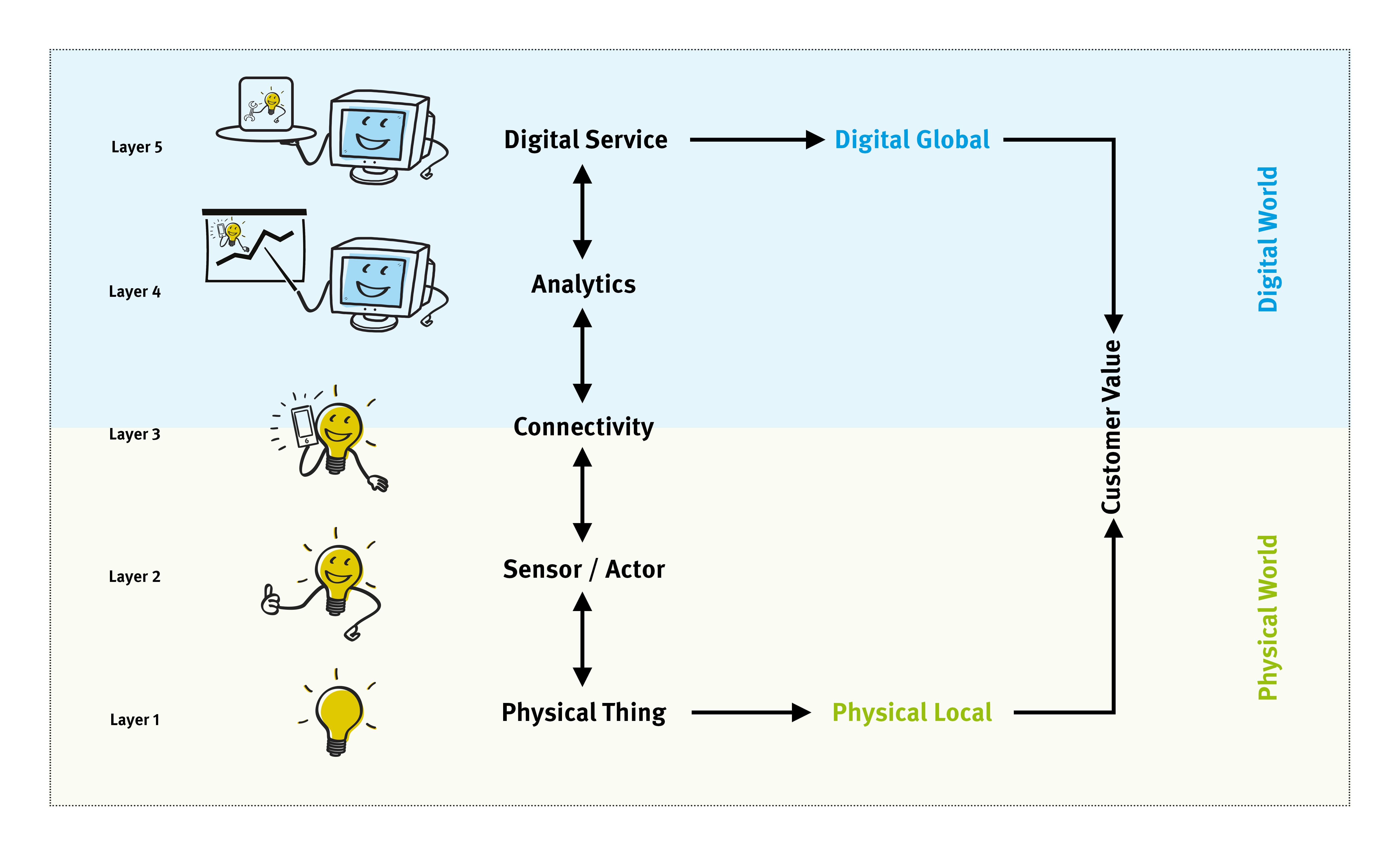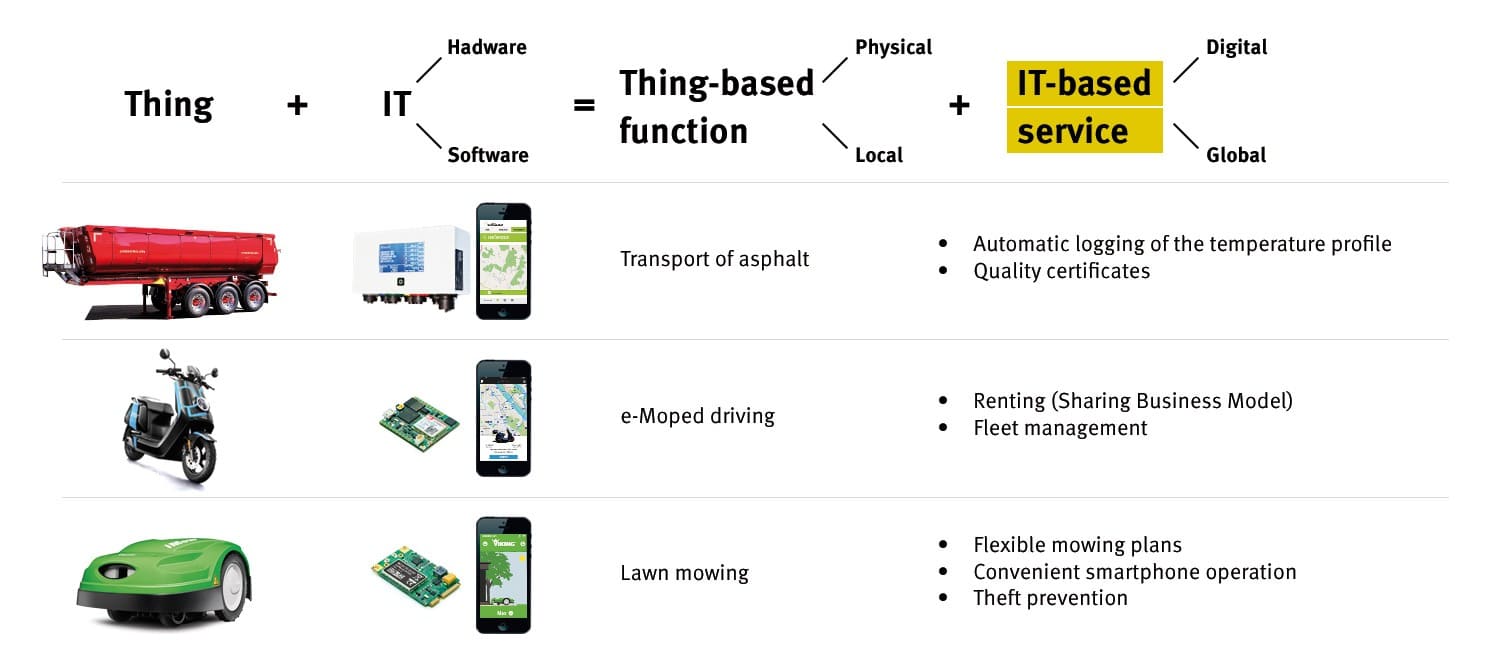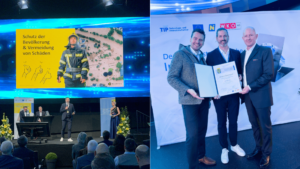On the manufacturer side the value of an IoT application consists of a conventional, not linked to the Internet, product. By using IT, the product is refined and a smart, connected product is created.
This refinement has already been explained in detail in 5 value-creation layers for IoT application. The conventional, physical product is on layer 1 and is refined by layer 2 to 4. On the customer side, the in this way generated value on layer 5 represents the benefit of the physical product and the associated digital service.[1]

The result is more than the sum of the layers based on the product – especially due to the simple and cost-effective possibilities of combining external, digital services with one’s own.[1]
Product service logic in the Internet of Things
A smart, connected product is created by adding IT to a conventional physical thing. The IT consists of hardware and software.
The thing-based function is physical and local. This function is independent of IT. IT-based services will be added to the thing for refinement of the thing with IT. The IT-based services are digital and global and going far beyond the local boundaries of the product.

The physical and local benefits of tipping semi-trailers with thermal insulation from Schwarzmüller still transports asphalt, even if it is equipped with a smart, connected measuring system, the Wicell. The additional benefit for the freighter is the automatic logging of the temperature development during the transport. The central storage of the protocol in the cloud is also automatic. This enables the freighter to provide proof o quality to his customer at any time.
The start-up goUrban rents e-mopeds in Vienna. The physical and local benefits remain the driving with an e-moped and the bridging of a distance. The additional IT-based benefit enables renting based on the sharing concept. In addition, fleet management is made possible because goUrban always knows where the e-mopeds are and is informed about critical operating parameters, such as the rechargeable battery state of charge.
Lawn mowing is the physical and local benefit of Viking’s iMow. The smart, connected iMow also features the global, digital benefits of flexible mowing schedules and the convenient configuration of these via a smartphone app. Theft protection is also implemented via GPS tracking.
Reference List
- ↑ Fleisch, E., Weinberger, M., & Wortmann, F. (2014, August). Geschäftsmodelle im Internet der Dinge. Bosch IoT Lab White Paper. Abgerufen von White-Paper.pdf
- ↑ Fleisch, E., Weinberger, M., & Wortmann, F. (2014, August). Geschäftsmodelle im Internet der Dinge. Bosch IoT Lab White Paper. Abgerufen von White-Paper.pdf, S. 7 – eigene Darstellung
- ↑ Fleisch, E., Weinberger, M., & Wortmann, F. (2014, August). Geschäftsmodelle im Internet der Dinge. Bosch IoT Lab White Paper. Abgerufen von White-Paper.pdf, S. 8 – eigene Darstellung mit eigenen Beispielen
Series: Moving into a new business era with smart, connected products
Part 1: Introduction
Part 2: The importance of business model innovation
Part 3: Laying the foundation through strategic decisions
Part 4: Breaking the valid industry logic
Part 5: 5 value stages of an IoT application
Part 6: Transforming the value chain
Part 7: The value generation of things in the Internet of Things
Part 8: Fundamental design of smart, connected products
Part 9: Requirements for the technological infrastructure in the Internet of Things
Part10: Creating added value by advancing to smart products


